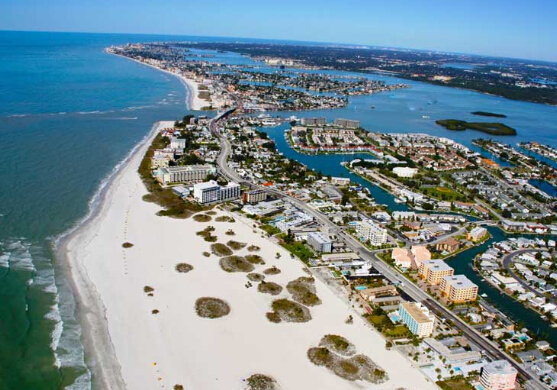

Treasure Island is a man-made landform in San Francisco Bay and a neighborhood of the City of San Francisco. Built 1936-7 for the 1939 Golden Gate International Exposition, the island's World’s Fair site is a California Historical Landmark[4] with buildings having been listed on the NRHP, and the island's historical naval station and auxiliary air facility (for airships, blimps, dirigibles, planes and seaplanes) are designated in the Geographic Names Information System.[3]
Prior to the island's construction by the federal government of the United States, "Yerba Buena Shoals" of rock[1] north of the transbay island had less than 27 ft (8.2 m) clearance and were a shipping hazard.[7] The 400-acre (1.6 km2) island was constructed by emplacing 287,000 short tons (260,000 t) of quarried rock "in the shoals" for the island/causeway perimeter "rock walls" (a freshwater reservoir was quarried in the rock of Yerba Buena Island).[7] Approximately 23 feet (7.0 m) of dredged bay sand filled the interior, was mitigated from salt, and then 50,000 cubic yards (38,000 m3) topsoil[7] was used for planting 4,000 trees, 70,000 shrubs, and 700,000 flowering plants.[1] Facility construction had begun by March 4, 1937 when two hangars were being built.
"On Monday, February 18, 1939, the 'Magic Isle'" opened[1] with a "walled city" of several fair ground courts: a central Court of Honor, a Court of the East, a Port of Trade Winds on the south and on the north: a Court of Pacifica, a 12,000-car parking lot, and the adjacent Gayway of 40 acres (16 ha) with thrill rides and shows.[7] The island had a lagoon ("lake of All Nations"), and structures included the "400-foot Tower of the Sun" (with reflecting pools), the International Building, the $1.5M Federal Building, the Hall of Western States, the $800K administration building, various exhibit halls for industries (e.g., "Machinery, Science, and Vacationland"), and two 335-by-78-foot (102 m × 24 m) hangars planned for post-exposition use by Pan Am flying boats (e.g., the China Clipper through 1944[4]) using the Port of Trade Winds Harbor later referred to as Clipper Cove between the two islands. In addition to Building 2 (Hangar 2) and Building 3 (Hangar 3), remaining exposition buildings include Building 1 (Streamline Moderne architecture) intended after the expo as the Pan American World Airways terminal. The expo's Magic Carpet Great Lawn also remains.)[8]
Naval Station Treasure Island began under a 1941[9] war lease as a United States Navy "reception center"[10] and in 1942, the Navy offered to exchange its Mills Field on the San Francisco Peninsula for the island. "The U.S. Navy seized Treasure Island" on April 17, 1942[9] and instead of an island airport, the city built an airport at Mills Field that became the San Francisco International Airport (the naval station closed in 1997). The station had a Naval Auxiliary Air Facility[3] and a Navy/USMC electronics school.[11] The Navy band stationed at Treasure Island, one of over 100 World War II Navy bands of African American musicians, was popular throughout the San Francisco area. Like most of these bands, its members trained at the Great Lakes bases in Chicago. They were recruited to serve "for the duration" at Treasure Island at a starting pay of $66 per month.[12] The 21-piece band played for morning colors, and at bond rallies and ship launchings, and at other events. The swing band, a smaller ensemble taken from the whole band, was known as the Shipmates of Rhythm and was one of the best bands in the Navy. They performed on the station's weekly radio broadcast, "Skyway to Victory," and were regulars at the Stage Door, a USO club that after the war became the Stage Door Theater. Clyde Kerr, who joined the band in 1944 from the New Orleans Lakefront band, continued to arrange and compose music for stage and traveling shows that performed at the Stage Door, where he worked with Harry James and other well-known musicians of the day, and the "Shipmates" performed behind Humphrey Bogart, Betty Grable, and other Hollywood stars.[13] The station was identified by the 1991 Base Realignment and Closure Commission, and remaining military structures include Bldg. 600 on Avenue M and 10th Street (former Naval Firefighting School, now SFFD's Treasure Island Training Facility), Bldg. 157 (Navy Fire station 2 built circa 1942 wood frame building which lacks modern earthquake Seismic retrofit) on Avenue D and 10th Street (now SFFD Station 48), and the 20,000 sqft (1,900 m2) Bldg. 180 by US Naval Station Way & California Ave (now a winery).[14]



















